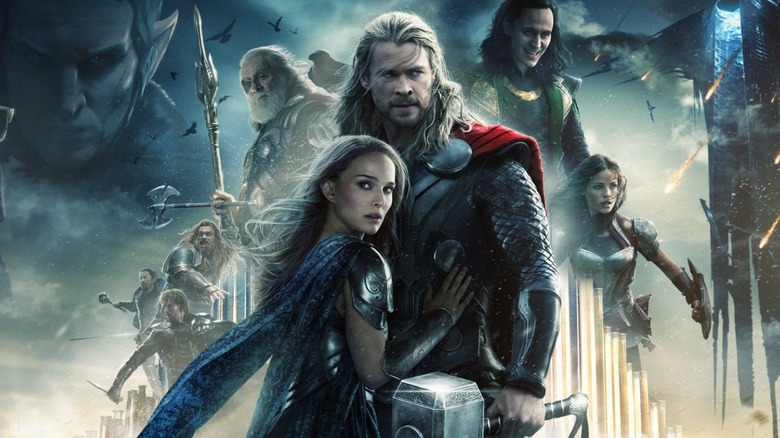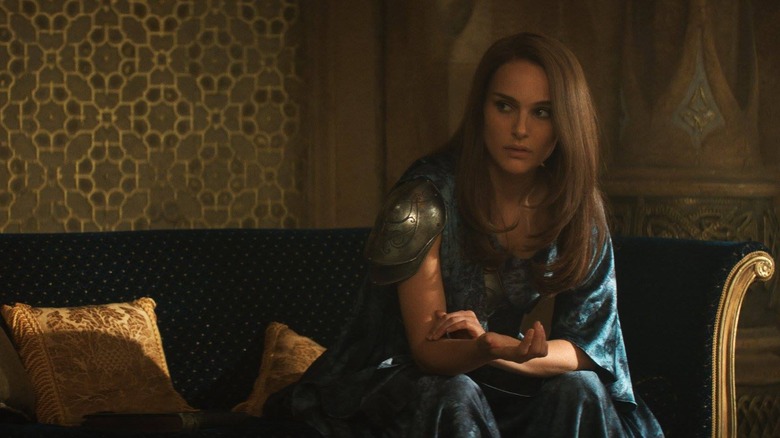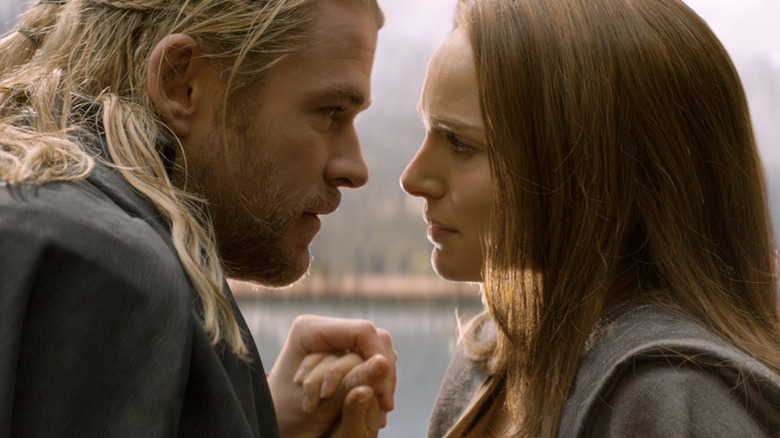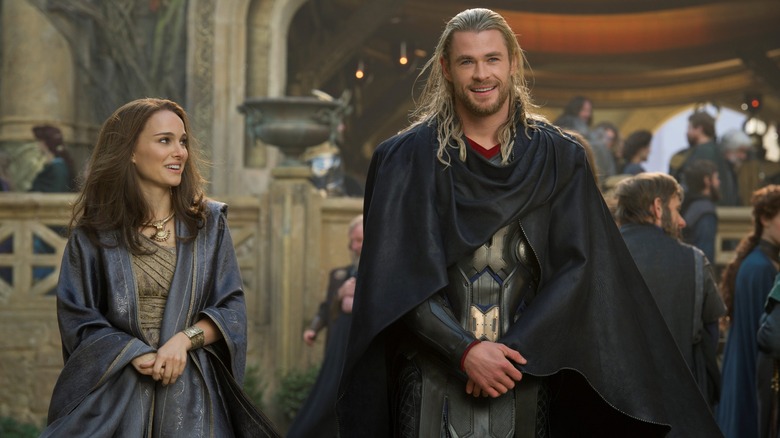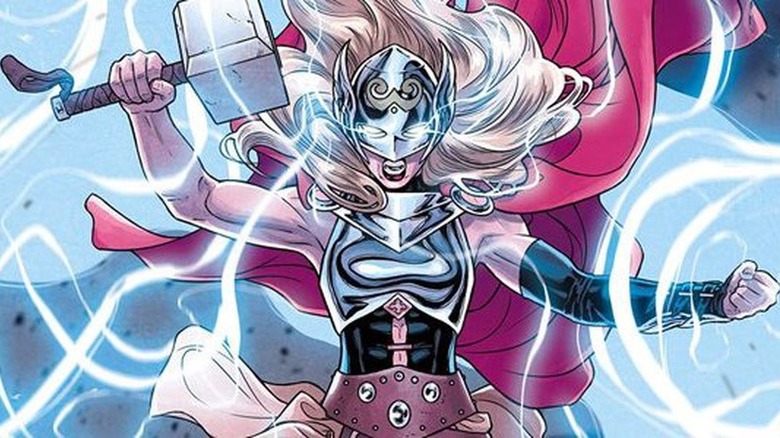Thor: The Dark World Originally Had A Much Different Ending For Thor And Jane
Despite what /Film's review said about it back in 2013, many True Believers agree that "Thor: The Dark World" is probably one of the worst offerings from the Marvel Cinematic Universe to date. Even Thor himself agrees that it just wasn't very good. (It's definitely my least favorite MCU movie, despite having a poster for it hanging above my desk. But it's signed by Stan Lee!)
Script issues like an overabundance of exposition and the terrible misuse of Christopher Eccleston's Malekith the Accursed plague the Phase Two film from Alan Taylor. But one of the biggest problems with the Asgardian Avenger's second solo film is the ending. Aside from the mischievous reveal to surprise the crowd before the credits roll, it feels abrupt and lacks substance. However, things weren't always this way.
Thanks to the Infinity Saga box set released in 2019, which includes a bonus disc with never-before-seen deleted scenes and alternate takes that had been locked up in the Marvel vault until that point (like the version of Samuel L. Jackson's "Iron Man" post-credits scene that mentions Spider-Man and the X-Men), fans have been able to catch a glimpse into a timeline where "Thor: The Dark World" actually had a much better ending.
I'm A Damsel. I'm In Distress. I Can Handle This. Have A Nice Day!
When Kenneth Branagh's "Thor" was released in 2011, Jane Foster jumped from originally being a lovelorn nurse to the God of Thunder's Midgard alter ego Dr. Donald Blake in the comics, to becoming one of the MCU's leading astrophysicists and astronomers. Unfortunately, she was basically relegated right back to a damsel in distress in the sequel. She required protection from just about everybody and even saw Thor's mother Frigga give her life to save Jane. But things were set to play out differently under a different director.
Before Alan Taylor signed on to direct "Thor: The Dark World," Patty Jenkins was attached to the project. In an interview with Buzzfeed promoting "Wonder Woman," Jenkins revealed what she had planned to do if she had stuck with the Marvel movie:
"I pitched them that I wanted to do 'Romeo and Juliet.' I wanted Jane to be stuck on Earth and Thor to be stuck where he is. And Thor to be forbidden to come and save Jane because Earth doesn't matter. And then by coming to save her ... they end up discovering that Malekith is hiding the dark energy inside of Earth because he knows that Odin doesn't care about Earth, and so he's using Odin's disinterest in Earth to trick him. And so it was like, I wanted it to be a grand [movie] based on 'Romeo and Juliet," ... a war between the gods and the earthlings, and Thor saves the day and ends up saving Earth."
Of course, the elements of grand love and being torn apart by two worlds left with Jenkins. However, this alternate ending on the Infinity Saga bonus disc seems to show hints of that storyline sticking around for a little while after her departure.
For Asgard! For Midgard!
The scrapped ending starts with Thor waking up on Earth after his battle with the Dark Elves. Odin didn't feel that his son would be able to make the trip back to Asgard in his condition, so the All-Father cared for him in Jane Foster's London apartment for three days. In that time, Odin got to know Jane better and realized that Thor was not actually blinded by passion when deciding what to do about Malekith. This wisdom made Thor even more worthy of the throne in his father's eyes.
Thor's three-day recovery period also proved to Jane that they cannot be together. Upon some careful reflection, she determined that they each have their own parts to play in the universe. Jane is committed to her work and Thor needs to be the Protector of the Nine Realms and eventually the King of Asgard. Angry at her decision, Thor proclaims, "I do not burn to be king." Jane thoughtfully replies, "That's why you'll be a great one." Though their feelings for each other are still strong, they were, in Thor's words, "drawn together for this and only this." The couple was essentially acting as the universe's defense mechanism against the Convergence, so Thor accepts that they were meant "to preserve life, not to share it." But that doesn't mean that they can't share one more very passionate kiss before saying goodbye. Thor and Odin return to Asgard and Jane is left with Darcy Lewis and Erik Selvig to contemplate the future.
We Can Work It Out
Clearly, the filmmakers needed to pivot because at some point they were told that they needed Loki alive and Thor off the throne by the end of this movie. But with a few slight changes, this alternate ending could have been much more satisfying, especially for Jane Foster.
Instead of being a damsel in distress, this ending depicts Jane as a more complex character. Natalie Portman's character is greatly conflicted in this scene because she loves Thor, but also recognizes that she would hold him back from realizing his full potential as King of Asgard somewhere down the line. Plus, if she were to be with Chris Hemsworth's mighty Avenger in another realm, she would abandon her advancements in scientific research that she had worked so hard to uncover. Instead, Dr. Foster is given a legitimate sense of agency. She recognizes what needs to be done, so she breaks things off and accepts the consequences.
An argument could be made that this ending would also foreshadow Jane's future in "Thor: Love And Thunder." This agency could factor into the reason that she becomes worthy enough to wield the powers of Thor. Instead, the movie ends with the God of Thunder returning to Earth to be with Jane, before they break up offscreen at some point before "Avengers: Age of Ultron," and we don't see her again until "Avengers: Endgame." It's such a disservice to the character, so hopefully she gets some justice in Taika Waititi's upcoming Phase Four film.
As for the Trickster God, he just needed to take Odin's place in order to sit on the throne, right? If that's where Kevin Feige and company needed him to be, there was a simple solution: Thor was knocked out for three days after his battle with the Dark Elves. Loki could've slid into the apartment unnoticed right under Jane, Erik, and Darcy's noses to take Odin's place. Then, once back on Asgard, Odin's shadow could've revealed Loki's presence to the audience, much like the reflection in the post-credits scene of "Thor" did. Or the movie still could've ended with Loki reverting to his true form while sitting on the throne, as seen in the theatrical cut. Just tack that on to the alternate ending. Voila! It's not like Loki's rule of Asgard factored into anything important anyway. "Thor: Ragnarok" quickly moved past it (after a hilarious Matt Damon cameo) and launched into a new adventure.
Back To The Sacred Timeline
Surely, it's much easier to point out these faults in "Thor: The Dark World" with the benefit of hindsight. It even got a tiny bit of redemption thanks to "Avengers: Endgame." But unless Marvel Studios grants Alan Taylor an alternate cut of the movie, which seems pretty unlikely at this point, the best we can hope for is that "Thor: Love And Thunder" brings Dr. Jane Foster back in the biggest and best way possible to make up for how dirty they did her in the past. We'll see how it all plays out on May 6, 2022.
